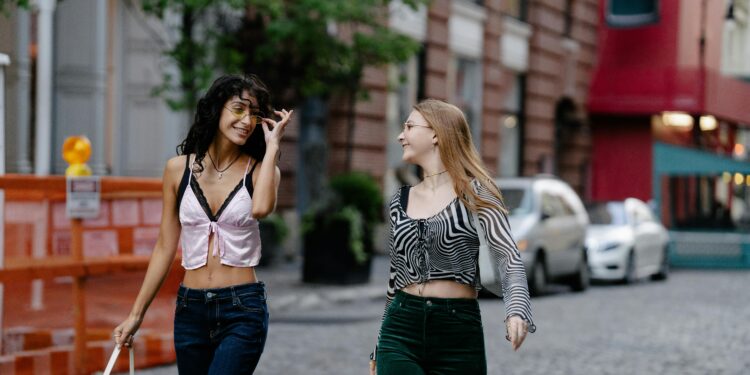Archival Dressing: Why Fashion Nostalgia is the New Innovation

Fashion’s future is being written in its past. For Gen Z, the hunt for innovation doesn’t always mean chasing the newest drop. It means rediscovering and reinterpreting styles that defined earlier decades. From Y2K fashion staples to archival runway collections, young trendsetters are proving that nostalgia is not only chic but also cutting-edge.
TikTok, Depop, and Instagram are fueling this shift, where “new” often means a vintage Prada bag, Carhartt workwear reworked into streetwear, or a pair of Y2K jeans sourced from thrift stores. In a digital world obsessed with fast novelty, archival dressing offers something richer: authenticity, history, and cultural resonance.
Y2K Fashion: The Blueprint of Gen Z Style
At the centre of this movement is the revival of Y2K fashion, a look once dismissed as cringe but now celebrated for its playful mix of futurism and kitsch. Think low-rise jeans, rhinestone accessories, butterfly clips, and metallic fabrics.
The Y2K aesthetic speaks to a generation caught between analogue nostalgia and digital futurism. Gen Z wasn’t old enough to fully live the original era, which makes adopting its wardrobe a form of cultural remix.
What’s innovative here is the reinterpretation of the original Y2K fashion: cropped cardigans are styled with sneakers instead of stilettos, and old-school Juicy tracksuits are layered with minimalist basics.
Thrifting as Cultural Innovation
Archival dressing thrives in secondhand culture. Platforms like Depop, Grailed, and local thrift stores have become treasure hunts for rare Y2K jeans and discontinued designer drops. Gen Z’s enthusiasm for thrifting isn’t just about affordability. It’s also about sustainability and individuality.
Fast fashion offers quantity, but archival fashion delivers a story. Owning a vintage Carhartt jacket or an early 2000s Dior saddle bag signals not just taste but cultural literacy. This practice transforms thrifting into a form of innovation: a curated alternative to mass-produced trends.
Pop Culture’s Archival Revival
Archival dressing isn’t confined to TikTok OOTDs. It’s heavily shaping pop culture. Music videos are filled with references to early 2000s visuals: pink Motorola Razrs, bedazzled denim, and futuristic sunglasses.
Artists like PinkPantheress and groups like Katseye tap into the Y2K aesthetic in their styling, blending nostalgia with modern sensibilities. Flip phones have also been making a strong comeback in recent years.
Influencers play a pivotal role here, too. Their Instagram carousels aren’t just fashion inspo, but also cultural archives. Posting a rare McQueen piece or styling thrifted vintage Prada instantly turns them into both curator and innovator, bridging eras through iconic Y2K fashion visuals.
TikTok and the Micro-Trend Engine
No discussion of Y2K fashion would be complete without TikTok. The platform is where archival dressing morphs into micro-trends that spread globally in days. One week it’s the return of “indie sleaze,” the next it’s cyber-core metallics, then back to fitted pastel Y2K baby tees.
The TikTok algorithm rewards niche content, which allows trends rooted in vintage or secondhand finds to flourish. This cycle has made archival pieces more desirable, since they offer both rarity and virality. Thrift flips, unboxings of vintage finds, and style challenges drive a culture where dressing “old” feels brand new.
Carhartt and Workwear’s Unexpected Role
One surprising hero of archival dressing is Carhartt, a brand originally designed for workers now embraced as a streetwear staple. Vintage oversized jackets and cargo pants are recontextualised as statements of rugged authenticity by today’s fashionistas.
This reflects a broader trend: archival dressing is about reinterpreting utility as aesthetic. Vintage Carhartt pieces circulate on resale platforms as coveted finds, proving that durability and cultural storytelling can elevate even humble workwear into high fashion.
The Luxury Resale Boom
Luxury brands are also benefiting from the archival wave. Rare pieces from Tom Ford’s Gucci era or Galliano’s Dior collections are skyrocketing in value on resale platforms. For many Gen Z buyers, these aren’t just clothes, but investments and cultural artefacts.
The irony? By looking backwards, fashion is creating its most future-facing economy. Brands like Prada and Balenciaga now dig into their archives for inspiration, proving that quiet innovation often comes from nostalgia.
Archival Dressing as Identity
Ultimately, archival dressing isn’t just about clothes—it’s about identity. Wearing Y2K fashion or rediscovered runway looks allows the new generation to signal belonging to a global community of style-savvy peers. It’s a way of saying: I know the references, I’ve done the work, I’m part of the conversation.
This phenomenon also reflects a desire for permanence in an era of fleeting digital culture. Owning a tangible piece of fashion history grounds style in legacy, not just likes.
Beyond the clothes, the Y2K aesthetic represents a deeper tension in pop culture: the push and pull between longing for a simpler, more optimistic digital age and shaping a sustainable, self-aware future.
Why Y2K Fashion Still Feels Like the Future
The return of Y2K fashion is more than a recycled trend. It’s a cultural statement. Wearing Y2K jeans, cropped cardigans, and reissued Carhartt jackets isn’t just nostalgia. It’s an act of curation, a way to remix the past into something personal and present.
When stars reference retro runway looks in their videos, or when everyday thrifters create “archival” fits from secondhand racks, they’re participating in a new kind of innovation. One that says the past still has unfinished business in the present.
In that sense, Y2K fashion is not a step backwards but a cultural loop. It’s proof that memory, identity, and style are never linear.
And sometimes the boldest way forward is to look back, then wear it better.








